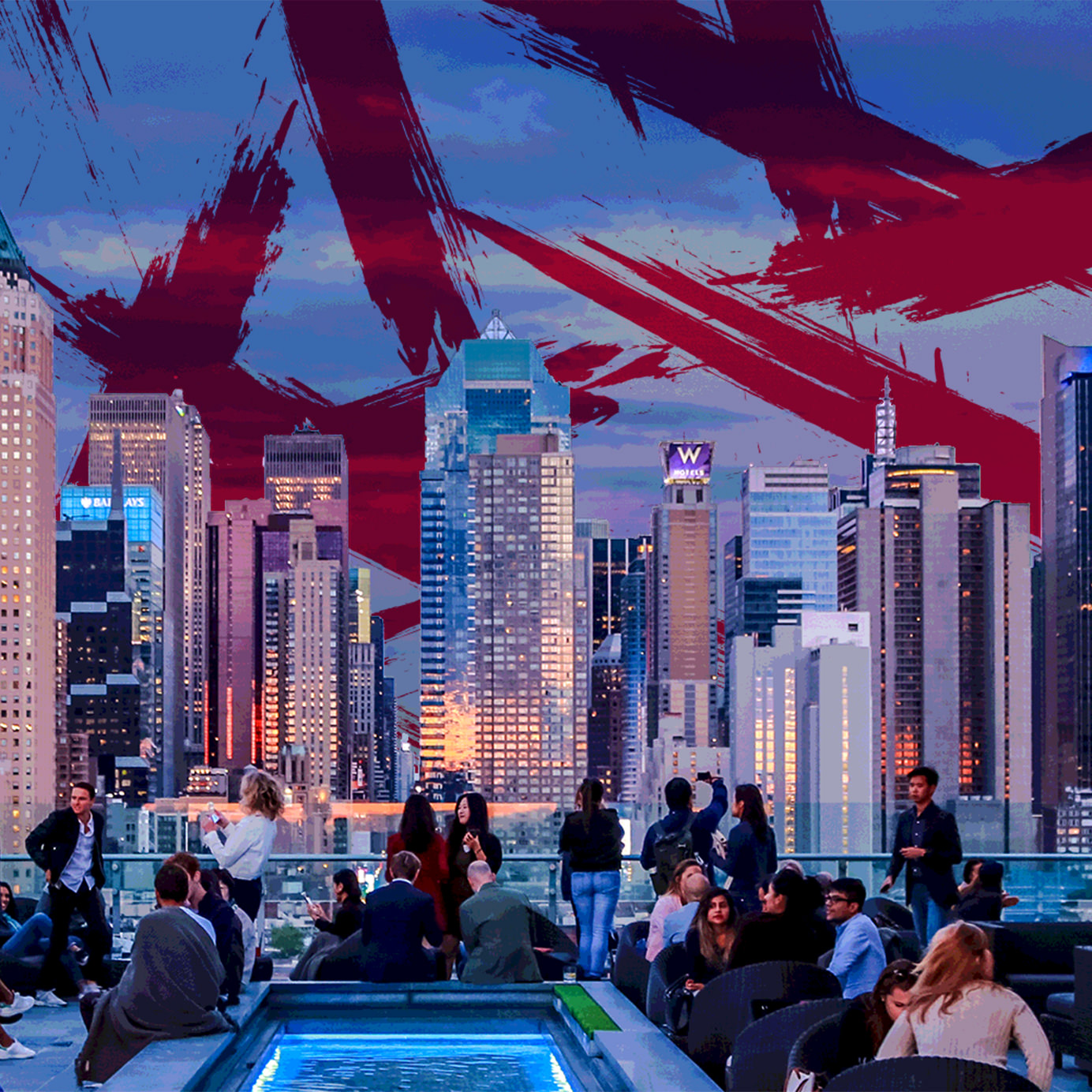Rooftop bars are irresistible.
If you meet friends at one tonight, the vista might include a city skyline or nearby waterfront. It will look great in photos. You will look great in photos. Someone in your vicinity will say, “Whoa, epic!” before night’s end.
But if you go to a rooftop bar tonight or any other night, you will not have a good time.
This sounds absolutist, but it’s a lot like when a friend says your local beer garden will probably be crowded on a sunny Saturday. It’s a logical assumption based on experience.
For reasons psychological and primal, something goes horribly awry once people are given the opportunity to drink and socialize en plein air. The environment stirs up an uncommonly alpha energy, lousy with entitlement and overpriced cocktails.
“With altitude comes attitude,” Frank Bruni wrote of NYC’s elevated offerings in The New York Times. The same can be said of rooftop bars from Dubai to Moscow to Nashville to Buffalo, N.Y.
“If it is difficult to get into a bar, especially if there is a bouncer who has a presumed ‘list,’ the experience of privilege is naturally heightened,” Dr. Joachim I. Krueger, professor of psychology at Brown University, explained in an email.
Height, too, is associated with “power and dominance. Taking an elevator to a rooftop bar hits both of these buttons,” Krueger says.
Granted, not all rooftop bars are entirely awful. The kitchen might be solid, as it is at Departure Lounge in Portland, Ore. The bartenders might spike drinks with seasonal homemade tinctures, as they do above the Thompson Hotel in Cabo San Lucas, Mexico, itself the citywide apotheosis of a rooftop bar.
These are the silver linings on a global nightlife storm cloud, though. Most rooftop bars have watery well drinks for which you will pay $16, and seas of unoccupied tables stubbornly labeled “reserved.” Overpriced bottle service is aggressively marketed by aloof servers whose artfully bored expressions hint at a rich inner life you will never know.
This is not a hypothetical description. This is 230 Fifth in Manhattan. A time capsule of pre-2008 excess, the multi-level rooftop bar occupies an expansive lot near the Beaux-Arts Flatiron Building and a now-defunct outpost of Derek Jeter’s 24-Hour Fitness. The views are stunning, especially the jaw-dropping proximity to the Empire State Building.
But it is a nightmare.
Swathes of the enormous space are roped off for phantom VIPs, making it feel cramped despite the reported 600-guest capacity. In 2015, a woman committed suicide off the roof of 230 Fifth, and patrons continued to drink because management did not close service.
Disrespect is a two-way street.
“I have never seen clientele act so aggressively as I have at 230 Fifth, and I have been bartending since 2004,” a former staffer we’ll call Corinne* wrote in an email. She described how guests would remove their shoes, climb on the furniture, and “eat oranges out of the bartender’s fruit trays and then throw the peels on the floor.
“I’ve even seen a girl urinate in a Champagne bucket,” Corinne adds.
This is surprising behavior at any establishment, be it a swank rooftop where peach Martinis run you $14, or a dive bar with Alice Cooper lyrics carved into a door-less bathroom stall. Why does open-air elevation bring out our worst behavior?
“Top floors are associated with privilege,” Krueger says. “This may affect patrons’ social behavior.”
Krueger carefully notes that diagnosing this as a phenomenon is tricky because it’s based on entirely anecdotal experiences. He’s absolutely right.
Still, it’s hard to shake the notion when our anecdotal evidence runneth over. I have personally seen patrons of various rooftop bars vomit into a decorative plant (Hong Kong), bully a sport-coat-wearing friend into jumping into a swimming pool (Miami), and flick smoldering cigarette butts onto foot-trafficked sidewalks below (Providence, R.I.).
“People on roofs are savage,” a bartender who we’ll call Nadine writes in a message. “They get up there entitled and ready to rage.”
Nadine recalls patrons’ lack of concern for elevator safety as they crammed their way up to the top floor at the venue where she used to work. One guest disposed of their chewing gum in the fresh mint sprigs at her station.
George Carney, another veteran of rooftop bartending, at one point worked at a venue where patrons threw items off the balcony and called the cops when they were asked to leave.
“I had a guy, in the middle of Thursday night service, piss on the front of the bar ‘cause it’s his birthday,” Carney says. Like Nadine, he uses the term “savage” to describe guests’ behavior.
Two new, buzzy rooftop bars opened in New York City this spring. Broken Shaker, one of the most anticipated spots of the season, debuted at the Freehand Hotel on May 9. And Ophelia Lounge opened in February in a landmark space above the Beekman Tower.
I have yet to go to either, in part because of the preceding 850 words, and because it’s been a really rainy spring in New York.
That’s the hitch. Despite it all, I find myself frequently, willingly patronizing rooftop bars. I want to like them. We all do.
Sipping booze atop a skyscraper makes us feel invincible, like society’s rules and precedents don’t apply to us. We ignore the obvious signs of an unpleasant environment (screamingly rude people, unscripted Champagne bucket use) and gaze into the horizon. If you squint, it starts to look kind of fun out there.
* – Corinne and Nadine requested we use pseudonyms because they both still work in nightlife, and drunk people are ruthless.
